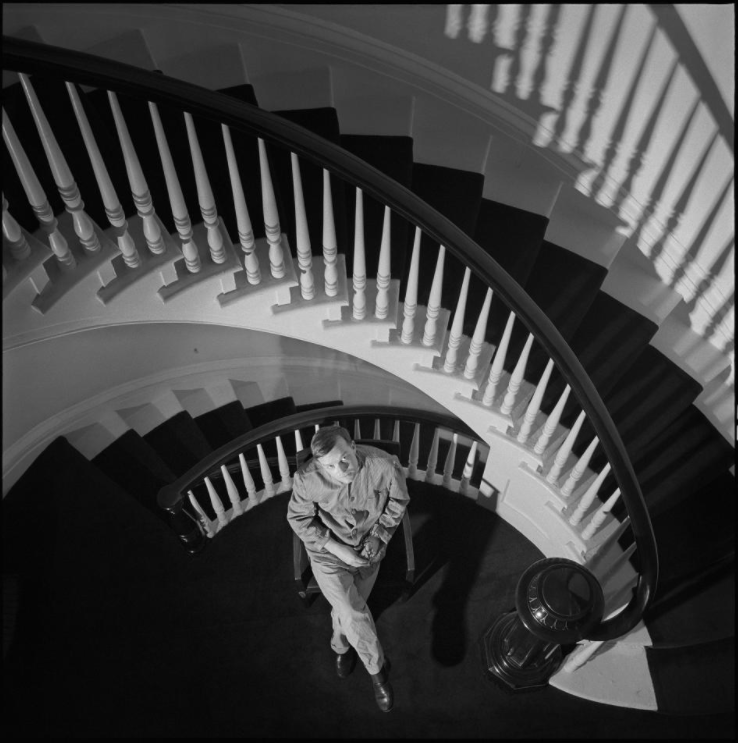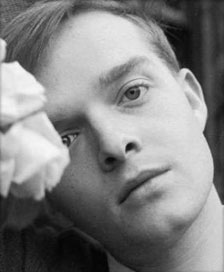A House On The Heights, Truman Capote

A HOUSE ON THE HEIGHTS
I live in Brooklyn. By choice.
Those ignorant of its allures are entitled to wonder why. For, taken as a whole, it is an uninviting community. A veritable veldt of tawdriness where even the noms des quartiers aggravate: Flatbush and Flushing Avenue, Bushwick, Brownsville, Red Hook. Yet, in the greenless grime-gray, oases do occur, splendid contradictions, hearty echoes of healthier days.
Of these seeming mirages, the purest example is the neighborhood in which I am situated, an area known as Brooklyn Heights. Heights, because it stands atop a cliff that secures a sea gull’s view of the Manhattan and Brooklyn bridges, of lower Manhattan’s tall dazzle and the ship-lane waters, breeding river to bay to ocean, that encircle and seethe past posturing Miss Liberty.
I’m not much acquainted with the proper history of the Heights. However, I believe (but please don’t trust me) that the oldest house, the oldest still extant and functioning, belongs to our backyard neighbors, Mr. and Mrs. Philip Broughton. A silvery-gray, shingle-wood Colonial shaded by trees robustly leafed, it was built in 1790, the home of a sea captain. Period prints, dated 1830, depict the Heights area as a cozy port bustling with billowed sails; and, indeed, many of the section’s finer houses, particularly those of Federal design, were first intended to shelter the families of shipmasters.
Cheerfully austere, as elegant and other-era as formal calling cards, these houses bespeak an age of able servants and solid fireside ease; of horses in musical harness (old rose-brick carriage houses abound hereabouts; all now, naturally, transformed into pleasant, if rather doll-pretty, dwellings); invoke specters of bearded seafaring fathers and bonneted stay-at-home wives: devoted parents to great broods of future bankers and fashionable brides.
For a century or so that is how it must have been: a time of tree-shrouded streets, lanes limp with willow, August gardens brimming with bumblebees and herbaceous scent, of ship horns on the river, sails in the wind, and a country-green meadow sloping down to the harbor, a cow-grazing, butterflied meadow where children sprawled away breezy summer afternoons, where the slap of sleds resounded on December snows.
Is that how it was? Conceivably I take too Valentine a view. However it be, my Valentine assumes the stricter aspect of a steel engraving as we mosey, hand in hand, with Henry Ward Beecher, whose church once dominated the spiritual life of the Heights through the latter half of the last century. The great Bridge, opened in 1883, now balanced above the river; and the port, each year expanding, becoming a more raucous, big-business matter, chased the children out of the meadow, withered it, entirely whacked it away to make room for black palace-huge warehouses tickly with imported tarantulas and reeking of rotten bananas.
By 1910 the neighborhood, which comprises sly alleys and tucked-away courts and streets that sometimes run straight but also dwindle and bend, had undergone fiercer vicissitudes. Descendants of the Reverend Beecher’s stiff-collared flock had begun removing themselves to other pastures; and immigrant tribes, who had first ringed the vicinity, at once infiltrated en masse. Whereupon a majority of what remained of genteel old stock, the sediment in the bottom of the bottle, poured forth from their homes, leaving them to be demolished or converted into eyesore-seedy rooming establishments.
So that, in 1925, Edmund Wilson, allowing a paragraph to what he considered the dead and dying Heights, disgustedly reported: “The pleasant red and pink brick houses still worthily represent the generation of Henry Ward Beecher; but an eternal Sunday is on them now; they seem sunk in a final silence. In the streets one may catch a glimpse of a solitary well-dressed old gentleman moving slowly a long way off; but in general the respectable have disappeared and only the vulgar survive.
The empty quiet is broken by the shouts of shrill Italian children and by incessant mechanical pianos in dingy apartment houses, accompanied by human voices that seem almost as mechanical as they. At night, along unlighted streets, one gives a wide berth to drunkards that sprawl out across the pavement from the shadow of darkened doors; and I have known a dead horse to be left in the road—two blocks from the principal post office and not much more from Borough Hall—with no effort made to remove it, for nearly three weeks.”
Gothic as this glimpse is, the neighborhood nevertheless continued to possess, cheap rents aside, some certain appeal that brigades of the gifted—artists, writers—began to discover. Among those riding in on the initial wave was Hart Crane, whose poet’s eye, focusing on his window view, produced The Bridge. Later, soon after the success of Look Homeward, Angel, Thomas Wolfe, noted prowler of the Brooklyn night, took quarters: an apartment, equipped with the most publicized icebox in literature’s archives, which he maintained until his “overcrowded carcass” was carried home to the hills of Carolina.
At one time, a stretch of years in the early forties, a single, heaven knows singular, house on Middagh Street boasted a roll call of residents that read: W. H. Auden, Richard Wright, Carson McCullers, Paul and Jane Bowles, the British composer Benjamin Britten, impresario and stage designer Oliver Smith, an authoress of murder entertainments—Miss Gypsy Rose Lee, and a Chimpanzee accompanied by Trainer.
Each of the tenants in this ivory-tower boardinghouse contributed to its upkeep, lights, heat, the wages of a general cook (a former Cotton Club chorine), and all were present at the invitation of the owner, that very original editor, writer, fantai-siste, a gentleman with a guillotine tongue, yet benevolent and butter-hearted, the late, the justly lamented George Davis.
Now George is gone, and his house too; the necessities of some absurd civic project caused it to be torn down during the war. Indeed, the war years saw the neighborhood slide to its nadir. Many of the more substantial old houses were requisitioned by the military, as lodgings, as jukebox canteens, and their rural-reared, piney-woods personnel treated them quite as Sherman did those Dixie mansions.
Not that it mattered; not that anyone gave a damn. No one did; until, soon after the war, the Heights commenced attracting a bright new clientele, brave pioneers bringing brooms and buckets of paint: urban, ambitious young couples, by and large mid-rung in their Doctor-Lawyer-Wall Street-Whatever careers, eager to restore to the Heights its shattered qualities of circumspect, comfortable charm.
For them, the section had much to offer: roomy big houses ready to be reconverted into private homes suitable for families of old-fashioned size; and such families are what these young people either had made or were making at stepladder rates. A good place to raise children, too, this neighborhood where the traffic is cautious and the air has clarity, a seaside tartness; where there are gardens for games, quiet stoops for amusing; and where, above all, there is the Esplanade to roller-skate upon. (Forbidden: still the brats do it.)
While far from being a butterflied meadow, the Esplanade, a wide terracelike walk overlooking the harbor, does its contemporary best to approximate that playing pasture of long-gone girls and their brothers.
So, for a decade and longer, the experiment of reviving the Heights has proceeded: to the point where one is tempted to term it a fait accompli. Window boxes bloom with geraniums; according to the season, green foliated light falls through the trees or gathered autumn leaves burn at the corner; flower-loaded wagons wheel by while the flower seller sings his wares; in the dawn one occasionally hears a cock crow, for there is a lady with a garden who keeps hens and a rooster.
On winter nights, when the wind brings the farewell callings of boats outward bound and carries across rooftops the chimney smoke of evening fires, there is a sense, evanescent but authentic as the firelight’s flicker, of time come circle, of ago’s sweeter glimmerings recaptured.
Though I’d long been acquainted with the neighborhood, having now and then visited there, my closer association began two years ago when a friend bought a house on Willow Street. One mild May evening he asked me over to inspect it. I was most impressed; exceedingly envious. There were twenty-eight rooms, high-ceilinged, well proportioned, and twenty-eight workable marble-manteled fireplaces. There was a beautiful staircase floating upward in white, swan-simple curves to a skylight of sunny amber-gold glass. The floors were fine, the real thing, hard lustrous timber; and the walls! In 1820, when the house was built, men knew how to make walls—thick as a buffalo, immune to the mightiest cold, the meanest heat.
French doors led to a spacious rear porch reminiscent of Louisiana. A porch canopied, completely submerged, as though under a lake of leaves, by an ancient but admirably vigorous vine weighty with grapelike bunches of wisteria. Beyond, a garden: a tulip tree, a blossoming pear, a perched black-and-red bird bending a feathery branch of forsythia.
In the twilight, we talked, my friend and I. We sat on the porch consulting martinis—I urged him to have one more, another. It got to be quite late, he began to see my point: Yes, twenty-eight rooms were rather a lot; and yes, it seemed only fair that I should have some of them.
That is how I came to live in the yellow brick house on Willow Street.
Often a week passes without my “going to town,” or “crossing the bridge,” as neighbors call a trip to Manhattan. Mystified friends, suspecting provincial stagnation, inquire, “But what do you do over there?” Let me tell you, life can be pretty exciting around here. Remember Colonel Rudolf Abel, the Russian secret agent, the biggest spy
